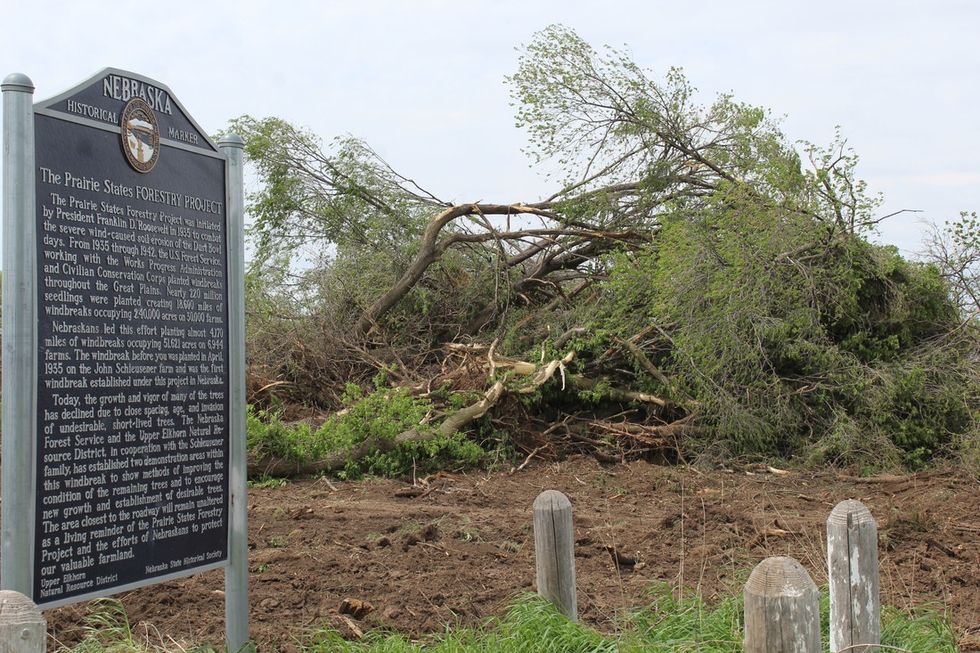Charred branches of history lay in a field north of Orchard leaving little to no reminder that just days ago it was a state-marked historical location with nearly a century-old shelterbelt.
Just 1½ miles north of Orchard, the historical site of the John Schleusener shelterbelt was the first windbreak planted in Nebraska under the Prairie States Forestry Project. On Wednesday, the trees were taken out leaving the community devastated.
“This used to be my family's farm. I think what I find most upsetting about what happened here is that removing shelterbelts, especially if it becomes a wide-spread practice, reexposes the land across the prairie to the patterns of wind which caused the Great Dust Bowl in the first place,” said Steve Schleusener.
According to the marker that was officially taken down on Monday, the shelterbelt was planted in April of 1935 under the Roosevelt administration in efforts to protect valuable farmland from wind erosion after the Dust Bowl. Nearly 220 million trees were planted, creating 18,600 miles of windbreaks occupying nearly 30,000 farms. Nebraska led the effort for the project with 4,170 miles of shelterbelts on nearly 6,944 farms.
The Schleusener windbreak was initially comprised of Willow, Red Cedar, Chinese Elm, Bur Oak, Black Walnut and Cottonwood. Over time, the original arrangement of trees changed, but the area closest to the roadway remained unaltered as a living reminder of the project until last week’s destruction of the shelterbelt.
Lyle Schleusener was three years old when the planting took place at his home. While he vaguely remembered the shelterbelt planted, he recalled a ceremony put on when the marker was constructed.
However, Jill Dolberg, review and compliance coordinator for the State Historical Society, said the site was not a historical landmark. In fact, landowners in 1985 applied for the land to become a historical marker in hopes for it to remain preserved. But with no restrictions placed on the agreement, preservation was not guaranteed while remaining on private property.
Requirements for a place to become a historical marker include the land being at least 50 years old and having historical significance.
“It’s like a child placed on the honor role. It’s a nice honor, but it doesn’t indicate the child’s future,” Dolberg said.
Schleusener said the shelterbelt was a mutual agreement between the family and the Works Progress Administration, an organization created to give people jobs through the Roosevelt administration. His wife, M.J. commented, it was good to plant trees because there wasn’t any shade.
“I’m sad to see it go,” she said.
Monty Shabram and Jerry Schwager erected the sign when it was first established, and Shabram said it was quite a process at the time.
“It’s kinda sad. I don’t think they needed to take it all out. They could have left a few trees along the road, and to me it wouldn’t have affected their farming too much,” Shabram said.
Brian Smith bought the property in April 2016. Dolberg said because the shelterbelt was only considered in a marker program, the landowner is allowed to no longer honor the implemented program. Smith burned the piles of trees Monday morning, and while he was attempted to be contacted about his project, he could not be reached.
Many in the community have expressed concern about the destruction.
“Something should be done about it,” said John Eley of Orchard.
The sign was removed Monday and was put into storage by Antelope County. Several members of the Orchard community, including Mayor Dennis Clifton, said they hope Orchard takes possession of the sign to display it as a monumental reminder of a time for Orchard’s history.
“It’s nice to have so many people motivated enough to reach out about it,” said Dolberg. “That doesn’t happen very often.”
Politics and ActivismMay 17, 2017
First Nebraska Windbreak Gone Forever
Trees are essential for the oxygen we breathe.
180



















